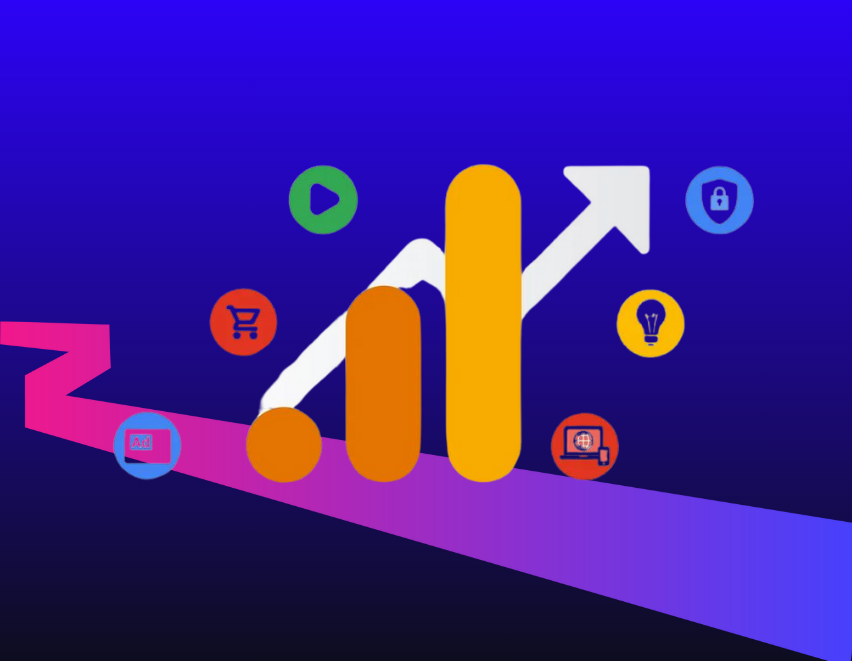Google Analytics 4 represents a fundamentally different way of collecting data, and signals the increasing overlap between web and mobile app content and development. Businesses that haven’t yet installed GA4 need to get conversant with it fast—there’s just a month to go before Google deprecates Universal Analytics and GA4 becomes the only data analytics service available on the platform.
On July 1, 2023, Universal Analytics (UA) accounts will stop collecting data, and a year later on July 1, 2024, Google Analytics 360 (GA360) accounts will also stop. They’re being replaced by Google Analytics 4 (GA4), a new Google product enabling users to collect web and app data separately or in one continuous property.
GA4 marks a major milestone in the tracking of web and app properties. Formerly called App + Web when announced in its beta stage in October 2020, GA4 builds on the foundation of cross-device unified measurement which Google introduced in July 2019. GA4 eliminates the need for manual stitching and workarounds between platforms, and ultimately quenches marketers’ thirst for unified data.
But if you haven’t implemented GA4 yet, read on and get ready—you don’t have long!
Have you seen the latest TikTok de-influencer trend?
This is basically where social media influencers slander a hyped up viral product and tells you exactly why you DON’T need it.
Is this going to be the death of influencing or another clever ploy to encourage you to buy a product. The double bluff?
What is Google Analytics 4?
GA4 isn’t a simple redesign of UA. It’s a whole new product, which until July 1, 2023 can be installed alongside your existing UA profile.
If you’re new to Analytics, however, GA4 is the default Google Analytics platform. It superseded UA in October 2020.
Google Analytics used to be divided between web properties—what we might think of as ‘traditional’ analytics—and Analytics for Firebase, which caters specifically to app needs.
GA4 unifies users’ data, and most importantly gives them flexible and powerful analytics tools within the bounds of cookieless tracking and consent management.
Universal Analytics vs Google Analytics 4: what’s changing?
Implementing GA4 doesn’t mean you have to get rid of your existing Analytics setup. For now you should keep that in place—its valuable historical data will be available for a further 6 months, and will complement the insights gathered from GA4. But as of July 1 next year, GA4 will become Google’s sole analytics platform.
If you’re setting up Analytics for the first time you can get started with GA4 right away, no need to create a separate UA profile. But if you’re transitioning from UA to GA4, a variety of changes are coming in the wake of growing data privacy restrictions.
Google Signals regionality
Launched in 2018, Signals is a Google product that collects data from users who’ve opted in to ad personalisation. The data is anonymised and made available to integrate into reporting and audience building. Signals can be disabled for specific countries and included for others. This level of control can be vital for political or socioeconomic reasons, because while not necessarily a GDPR requirement, it enables whole regions to be excluded from intake.
IP address logging
Google has deprecated IP logging; all processing for locations will now be passed through to GA. This meets GDPR requirements and mitigates any compliance issues that could arise during the transfer of personally identifiable information (PII).
Granular location and device data collection
Several data points are no longer default, including city, device information and browser versioning. Some companies may choose not to collect these data points for the sake of making sure they’re fully compliant with GDPR. Those data points that are no longer default can still be collected according to specified regions.
EU data
EU data was being moved to the US for processing, but this practice has been deprecated. EU data is now processed within the EU to comply with GDPR.
What new features does Google Analytics bring?
With GA4, a variety of metrics that users of UA are accustomed to have changed, deprecated, or been replaced.
From pageviews to views
GA4 prioritises views over pageviews because it unifies web and app properties: views encompasses screenviews and pageviews. But as was previously the case, repeated views of the same content are counted individually.
Identity Spaces
GA4 comes with four distinct identity methods, which together produce a unified view of cross-device user journeys:
- user ID
- device ID
- modelling
- Google Signals.
All data associated with the same user—that is to say, associated with the same identity—is assigned to the same identity space. Identity spaces are used across all GA4 reporting, enabling brands and advertisers to deduplicate their list of users and gain a richer understanding of their relationship and interactions with their businesses.
From average session duration to average engagement time
While the two metrics are calculated differently, average engagement time reports on what average session duration was always attempting to encapsulate: user focus on web- or screenpages.
New metrics
Goodbye outdated user behavioural measurements like bounce rate and average session duration. With GA4, new metrics for understanding behaviour include engaged sessions and engagement rates, which are both more impactful than the old metrics.
From goals to conversions
This change is mainly just semantic. It’s come about because of the deprecation of the category–action–label hierarchy of previous events. That being said, it’s still important to note that GA4 will count every instance of a conversion event, even if it occurs multiple times in the same session. For example, if the same user fills out a form three times in one session, that conversion is counted three times.
Multipurpose audience lists
When you create an audience in GA4, it’s automatically imported and becomes available for remarketing in Google Ads on YouTube and the Google Search and Display Networks. By contrast, advertisers using UA have to recreate audiences in Google Ads they’ve already created in Analytics.
From session to session start
GA4 slightly changes the definition of when a session is said to have been created. It’s now determined when a session start is triggered. This generates a session ID which is appended to each event that occurs within the session. Sessions end after 30 minutes or the defined timeout period. They can no longer restart at midnight or when new campaign parameters are encountered.
A different data display
UA’s data model is hit-based, characterised by sessions and pageviews. The latter are the starting point of data collection in UA, whereas in GA4 the key metric is events.
What are the business benefits of Google Analytics 4?
By leveraging AI and machine learning components for the near-cookieless future, GA4 is a step in the right direction in terms of giving businesses the insights they actually need.
Simplified and organised reporting
GA4 introduced several new reporting tools of interest to marketers and web analysts, and the existing web and app reports have been reorganised in the platform UI. The standout benefit from these changes is the unified user view between app and website, but it’s also worth noting that Google has revamped its custom reporting tool as an ‘analysis hub’. This offers more flexibility, with custom and ad hoc reporting.
Unified metric and dimension scopes
GA4 brings together the view between app and web, which is probably the single biggest advantage it brings. Previous iterations of Analytics required separate tagging and properties, which sometimes led to inconsistent metrics and dimensions. Just remember when you start out with GA4 that you won’t have any historical or 24-hour data, but you’ll soon start to see that populate.
New privacy-conscious data controls
Unified reporting and the user journey across platforms has been a perennial challenge since the dawn of app and web development. GA4 represents an acknowledgement of these needs and the fact that they’re growing increasingly complex in the face of exponentially more stringent data regulations. As privacy advocates criticise third-party data collection, Google is now ready to embrace anonymised first-party data instead, along with consented tracking. By unifying properties and collection scopes (and announcing significant server-side capabilities), Google is moving away from client-side dependencies.
What will my operations look like using Google Analytics 4?
Over the last few years we’ve seen users and sessions switch places in Analytics, a nod to a future in which analysts track users over session-by-session data. GA4 manifests this shift in full. Event-based tracking over hit-based tracking produces a degree of granularity in data that simply wasn’t possible before.
Meanwhile, old categories like action and label have been deprecated, and all interactions with a website are now ingested at the same level of granularity. A pageview happens at the same level of detail as a link click. This precise level-setting enables flexibility that would have been otherwise more limited. The question now is less “What happened in the session?”, more “How did the user behave in the session?” Fundamentally, data points are being translated into human actions.
How do I track my marketing data and create reports in Google Analytics 4?
You can set up a default attribution model for your reporting needs in Property Settings. You can also specify a lookback window, whose default is the last 30 days. This marks a stark evolution from UA, whose default was Last non-direct click, which couldn’t be changed across the account—different models were comparable only in a specific tab.
With GA4’s attribution models, direct visits are excluded from receiving attribution credit on all attribution models unless the conversion path was direct visits only. The models have been and will continue to be introduced on different dates, with their data available only from their start dates. If you select data outside the available window, you’ll only see some of it.
Analytics’ attribution reporting previously looked at how a website had acquired a user’s session, but GA4’s will focus instead on how the user was acquired in the first place, as well as how their subsequent sessions were acquired.
There’s also an exciting range of metrics exclusive to GA4:
- event count: number of hits or triggered events
- active users: number of users active in a 28-day period
- engagement rate: percentage of total sessions that were engaged sessions
- average engagement time: calculated summation of user engagement durations per active user
- engaged sessions: number of sessions that lasted longer than 10 seconds and had a conversion event or at least 2 views.
How do I migrate to Google Analytics 4?
GA4 is a new product unto itself. You can’t just hit an Update button in your existing UA or GA360 property—you must create an entirely new property for GA4, and your site will need the appropriate tagging to start collecting data.
While Google is providing a mirroring service to translate UA tags to GA4, you shouldn’t rely on it—indeed Google itself recommends that you don’t. The inherent differences in data structure will likely confuse your setup, and any issues or errors from your old setup may get carried forward into your GA4. Much better to start afresh with GA4, and prime your business for success as we hail a new era in analytics.
3 simple questions to ask before implementing Google Analytics 4:
- Should I migrate to server-side tracking?
- Is my app running the latest version of the Firebase SDK?
- Is my existing tag Tag Manager or gtag integration collecting all the data it should be?
Finally, remember that to have YoY data available in GA4 before the deprecation of UA and GA360, you’ll need to have fully implemented GA4 by July 1, 2023, the deprecation data for UA. Otherwise your GA4 will have gaps, and this will complicate your 2023 YoY reviews.
What if I don’t have time right now to learn how to use Google Analytics 4?
GA4 data is forward-facing from the date of installation—the sooner you get it, the more historical data you’ll have. For that reason you should add GA4 to your website ASAP.
Business owners are rushed off their feet—we get it. So even if you don’t have time right now to familiarise yourself with GA4, try to at least install it, as data capture will begin immediately. Leave it ticking along in the background. When you’re finally ready to learn how to use it, you’ll have a wealth of statistically significant information ready to go.
It may take a little time to get your head around GA4’s newly available insights. Historically, Analytics data has been driven by pageviews, providing metrics now familiar to us like bounce rate, the numbers of users and new users, and the number of sessions and their average duration. By contrast, GA4’s data is more oriented toward understanding the customer lifecycle, so includes information about retention, acquisition, engagement and monetisation.
Is it worth making the switch to Google Analytics 4?
Short answer: yes.
Long answer: hell yes!
If you still have two profiles—GA4 along with UA or GA360—it’s best to use them both individually and in tandem, with a view to seeing which metrics are related or influence one another. You’ll soon start connecting the dots. Moving forward, the understanding you’ll glean of how A impacts B and B impacts C will be invaluable.
Come the deprecation of UA we’ll see site owners who haven’t yet installed GA4 scramble to get it set up. There’s no sadder sight than a scrambling site owner. (Try saying that after you’ve had a few.) So start preparing as soon as possible. Export and maintain hard copies of historical data for your records—it won’t be transferrable from your UA or GA360 because of the differences in their data models and how their definitions function and operate.
Take all the time you can to get to grips with GA4. After all, ultimately you execute most of your business decisions according to Analytics, right? The data you work with moving forward must be as accurate as possible.
This is a seriously exciting time in analytics. Because GA4 introduces a whole new way of looking at your data. Of course that can feel daunting, especially if you’ve been accustomed to UA or GA360 for years—but once you see the myriad possibilities open up before you, you’ll wonder how you ever went without.
If you need some help or advice, whether with exporting your data from UA or GA360, or familiarising yourself with GA4’s interface and methodology, or understanding how to leverage its insights, reach out to us. We’ve been running countless clients’ GA4 accounts since the platform superseded UA as Google’s default back in October 2020, and we’d be delighted to help you as well.






